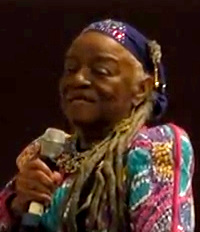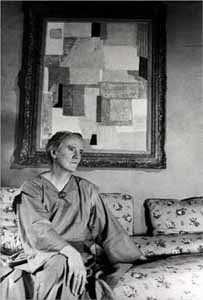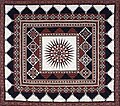
A quilt is a multi-layered textile, traditionally composed of two or more layers of fabric or fiber. Commonly three layers are used with a filler material. These layers traditionally include a woven cloth top, a layer of batting or wadding, and a woven back combined using the techniques of quilting. This is the process of sewing on the face of the fabric, and not just the edges, to combine the three layers together to reinforce the material. Stitching patterns can be a decorative element. A single piece of fabric can be used for the top of a quilt, but in many cases the top is created from smaller fabric pieces joined together, or patchwork. The pattern and color of these pieces creates the design.

Lenore "Lee" Krasner was an American abstract expressionist painter, with a strong speciality in collage. She was married to Jackson Pollock. Although there was much cross-pollination between their two styles, the relationship somewhat overshadowed her contribution for some time. Krasner's training, influenced by George Bridgman and Hans Hofmann, was the more formalized, especially in the depiction of human anatomy, and this enriched Pollock's more intuitive and unstructured output.

Faith Ringgold is an American painter, writer, mixed media sculptor, and performance artist, best known for her narrative quilts.

Barbara Nessim is an American artist, illustrator, and educator.
Frank Havrah "Kaffe" Fassett, MBE is an American-born, British-based artist who is best known for his colourful designs in the decorative arts—needlepoint, patchwork, knitting, painting and ceramics. While still a child, Fassett renamed himself after an Egyptian boy character from the book Boy of the Pyramid by Ruth Fosdick Jones. His name rhymes with 'safe asset'.
Quilt art, sometimes known as art quilting, mixed media art quilts or fiber art quilts, is an art form that uses both modern and traditional quilting techniques to create art objects. Practitioners of quilt art create it based on their experiences, imagery, and ideas, rather than traditional patterns. Quilt art generally has more in common with the fine arts than it does with traditional quilting. Quilt art is typically hung or mounted.

Anne Ryan (1889–1954) was an American Abstract Expressionist artist associated with the New York School. Her first contact with the New York City avant-garde came in 1941 when she joined the Atelier 17, a famous printmaking workshop that the British artist Stanley William Hayter had established in Paris in the 1930s and then brought to New York when France fell to the Nazis. The great turning point in Ryan's development occurred after the war, in 1948. She was 57 years old when she saw the collages of Kurt Schwitters at the Rose Fried Gallery, in New York City, in 1948. She right away dedicated herself to this newly discovered medium. Since Anne Ryan was a poet, according to Deborah Solomon, in Kurt Schwitters’s collages “she recognized the visual equivalent of her sonnets – discrete images packed together in an extremely compressed space.” When six years later Ryan died, her work in this medium numbered over 400 pieces.

Miriam Schapiro was a Canadian-born artist based in the United States. She was a painter, sculptor, printmaker, and a pioneer of feminist art. She was also considered a leader of the Pattern and Decoration art movement. Schapiro's artwork blurs the line between fine art and craft. She incorporated craft elements into her paintings due to their association with women and femininity. Schapiro's work touches on the issue of feminism and art: especially in the aspect of feminism in relation to abstract art. Schapiro honed in her domesticated craft work and was able to create work that stood amongst the rest of the high art. These works represent Schapiro's identity as an artist working in the center of contemporary abstraction and simultaneously as a feminist being challenged to represent women's "consciousness" through imagery. She often used icons that are associated with women, such as hearts, floral decorations, geometric patterns, and the color pink. In the 1970s she made the hand fan, a typically small woman's object, heroic by painting it six feet by twelve feet. "The fan-shaped canvas, a powerful icon, gave Schapiro the opportunity to experiment … Out of this emerged a surface of textured coloristic complexity and opulence that formed the basis of her new personal style. The kimono, fans, houses, and hearts were the form into which she repeatedly poured her feelings and desires, her anxieties, and hopes".
Pattern and Decoration was a United States art movement from the mid-1970s to the early 1980s. The movement has sometimes been referred to as "P&D" or as The New Decorativeness. The movement was championed by the gallery owner Holly Solomon. The movement was the subject of a retrospective exhibition at the Hudson River Museum in 2008.

Sue Reno is a fiber artist from Pittsburgh, Pennsylvania.
Sara Garden Armstrong is an American artist who lives and works in New York City. Armstrong creates sculptures, paintings, drawings, artist's books, multimedia artworks involving computers sound and light, and constructs permanent installations in atrium spaces. Armstrong received her Master of Fine Arts from the University of Alabama in Tuscaloosa and her Master of Art Education from the University of Alabama at Birmingham. Armstrong also studied art at New York University and with the University of Windsor, Windsor, Ontario in Yeovil, England while attending UAB. She was an educator for several years at the University of Alabama at Birmingham, later she moved to New York City in 1981.
Angie Lewin is a British printmaker working in linocut, wood engraving, lithography and screen printing.
Margaret Nairne Mellis was a Scottish artist, one of the early members and last survivors of the group of modernist artists that gathered in St Ives, in Cornwall, in the 1940s. She and her first husband, Adrian Stokes, played an important role in the rise of St Ives as a magnet for artists. She later married Francis Davison, also an artist, and became a mentor to the young Damien Hirst.
Charlotte Hodes, is a British artist.
Katherine Westphal was an American textile designer and fiber artist who helped to establish quilting as a fine art form.
Elizabeth Violet Polunin,, was a British artist and theatre designer, most notably for her work with Sergei Diaghilev and the Ballets Russes.
Martha Neill Upton was a watercolorist, sculptor and studio quilt artist. Her quilted tapestries helped quilts become seen as fine art, rather than craft work, during the early 1970s. Her quilts were shown in the first major museum exhibition of non-traditional quilts, The New American Quilt at New York's Museum of Arts and Design, then called the Museum of Contemporary Craft, in 1976.
Noela Hjorth was an Australian artist and builder of houses, known as living sculptures. Her work reveals a fascination with the female form and its spiritual manifestations, exploring the mythology of ancient civilisation, Western approaches to nature enshrined in Celtic and Druid traditions, and the mysticism of Eastern religion.
Bisa Butler is an American fiber artist who has created a new genre of quilting that has transformed the medium. Although quilting has long been considered a craft, her interdisciplinary methods -- which create quilts that look like paintings -- have catapulted quilting into the field of fine art. She is known for her vibrant, quilted portraits celebrating Black life, portraying both everyday people and notable historical figures. Her works now count among the permanent collections at the Smithsonian National Museum of African American History and Culture, the Art Institute of Chicago, and about a dozen other art museums nationwide. She has also exhibited at the Smithsonian Museum of American History, the Epcot Center, the National Underground Railroad Freedom Center, and many other venues. In 2020, she was commissioned to quilt cover images for Time magazine, including the "Person of the Year" issue and its "100 Women of the Year" issue. With a multi-year wait list for private commissions, one of Butler's quilts sold at auction in 2021 for $75,000 USD.
Joan Schulze is an American artist, lecturer, and poet. Schulze's career spans over five decades: she is best known for her work of contemporary quilts, fiberarts, and collage. Schulze has been named a “pioneer of the art quilt movement,” and her influence has been compared to that of Robert Rauschenberg’s. Her work is in galleries and private collections worldwide including the Renwick Gallery/Smithsonian Institution in Washington DC, the Museum of Arts and Design in New York, & the Oakland Museum of California.








